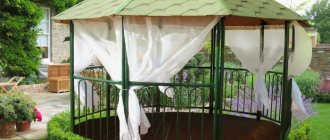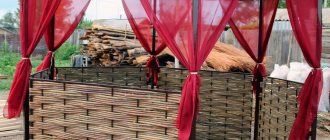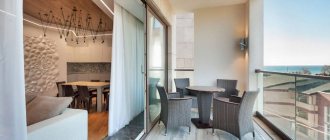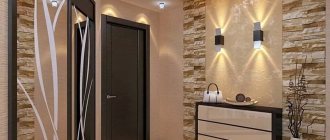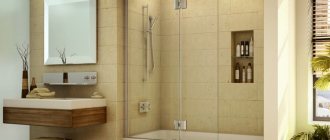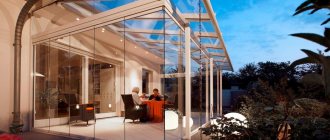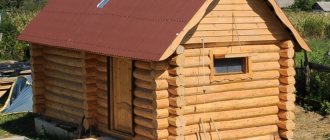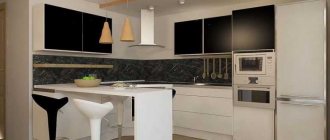There is one element for a summer residence that cannot be replaced by anything else. A rectangular gazebo is a structure that is erected in a short period of time, but will serve for quite a long time. Food eaten in the fresh air is digested better and brings more benefits, and spending time with your loved ones is priceless. In today's world filled with electronics, many people forget about face-to-face communication. But this is precisely the key to strong relationships. Next we will look at how a rectangular gazebo can be built with your own hands.
DIY metal gazebo. Photos, drawings and diagrams of structures
In addition to wood, metal is often used to build gazebos: iron or aluminum. This material is durable and products made from it do not require repair. The elements are connected using welding. Models of metal gazebos can have a stationary or collapsible design. In the case of a collapsible version, bolted connections are used as fastening.
Hexagonal metal gazebo with pointed roof
When planning the location of the gazebo, it is necessary to take into account that metal elements become very hot in hot weather. In this regard, it is recommended to make such structures open and install them in the garden.
Before starting the project, it is necessary to think over the design of the gazebo, which would match the style of the existing exterior. The dimensions included in the drawings of a do-it-yourself metal gazebo depend on the expected number of people who can be inside it, as well as the furniture and the availability of certain equipment (barbecue, barbecue).
Drawing of a metal gazebo with forged elements
Many people use ready-made diagrams for constructing metal gazebos with their own hands, photos of which can be found on the Internet. The rectangular design with dimensions of 2.5x3 m is relatively easy to install. This model will not be bulky and at the same time it can accommodate a table and several seats for comfortable rest.
Do-it-yourself gazebos from a profile pipe. Drawings, photos of finished structures
Due to a number of properties of profiled metal pipes, many people use this material to build gazebos. Structures made from profiles are characterized by ease of construction, excellent weather resistance and durability. In addition, this material is relatively inexpensive, and structures made from profiles have a decent, neat appearance.
A gazebo made of a profile pipe, complemented by a fabric canopy
Before you begin making a gazebo, you need to select the type and shape of the structure, prepare drawings, and check the availability of the necessary materials and tools for installation. A photo of gazebos made from a profile pipe with your own hands demonstrates the various configurations of these structures: rectangular, hexagonal, square and other more complex shapes.
Project for arranging a rectangular gazebo made of metal profiles
You can make sketches and drawings of the gazebo yourself or use ready-made diagrams, proportionally changing the dimensions to suit your option. It is necessary to indicate all dimensions in the drawings and perform all calculations as accurately as possible, since the appearance of the structure and the selection of necessary materials will depend on this.
To construct the structure, the following materials will be needed: concrete, profile pipe, primer for treating metal surfaces, fittings, roofing material. The tools you will need are: a construction level, a drill with a set of drills, an angle grinder, a welding machine, a shovel, and fasteners.
Project of a square gazebo made of metal pipes with wooden benches
Having chosen and marked a place for the structure, they begin to construct holes. Their number is determined by the number of supports, according to the drawings. The pits are made about 60 cm deep. The height of the support posts is taken taking into account this value. For supports, a profile with a cross-section of 80x80 mm and a wall thickness of 3 mm is used, to which supporting metal heels are welded. This will give the structure additional stability.
The bottom of the prepared pits is covered with crushed stone, carefully compacted, support posts are inserted and concreted
At this stage, it is important to maintain maximum verticality of the installed racks. To do this, as soon as the concrete hardens a little, the position of each support is checked and leveled
Drawing of a gazebo made from a profile with a square section
After installing the supports, it is necessary to wait about 2 days until the concrete sets completely, and then proceed to the lower horizontal piping. For it, a profile of a smaller cross-section is used, which is welded to the supports at a certain height above the ground. The distance from the ground to the horizontal harness is taken such that it is as comfortable as possible to enter the gazebo.
56d20ddab83d4edd915d6590eb5a42c5.jpeNext, we begin to make the roof. A rafter system is formed from the profile according to the diagrams. For a gable shape, the profile is welded at an angle of 15 degrees. To make it easier to attach the roofing material, a profile pipe is welded to the roof frame as a sheathing in increments of 45 cm. At this point, the gazebo frame is considered assembled.
Scheme of a collapsible gazebo made of corrugated pipe measuring 20x20x2 mm
Conclusion
Sufficiently detailed drawings of rectangular gazebos can be found online on our website. At the same time, independent construction of a diagram is also quite within the capabilities of anyone who has at least a minimal understanding of engineering graphics.
Guided by the tips given, as well as by watching the video in this article, you will be able to master this technology and draw your future gazebo on paper or in a design program.
Did you like the article? Subscribe to our Yandex.Zen channel
Peculiarities
Gazebos can be classified according to different criteria. So, depending on the shape, they can be round, polyhedral, square or rectangular. Each type differs in design and design features, as well as in purpose.
Speaking of dimensions, they can be large, medium or small. Particularly popular are structures with dimensions of 3 by 4 meters - they can accommodate a large number of people without occupying a significant portion of the site.
There are also many materials from which you can create a gazebo.
The gazebo can be made from various materials
The wooden structure has a long service life and is presentable. But they require careful care and treatment with special means.
Metal structures will be strong and reliable, and the addition of artistic forging elements will add originality and attractiveness. However, in the heat, the metal heats up, and inside it becomes stuffy and uncomfortable.
Another popular material is polycarbonate. It is characterized by high light transmittance, it is transparent, and easy to install. It is also resistant to negative mechanical and weather influences. In addition, this material has an affordable price and there is a wide color palette. So, by choosing an orange polymer, you will have pleasant warm lighting even in cloudy weather.
Brick buildings are strong and reliable. They will last for decades. If you add a polycarbonate roof with good glazing to such a gazebo, it will truly become a design and architectural decoration for your site.
In this video you will learn more about how to make a 3 by 4 meter gazebo:
Let us note the fact that today there are trends towards combining several types of materials: wood with polymer or lining, glass and brick, metal barbecue. The combination of different materials provides additional functional and aesthetic benefits.
Special attention should be paid to the roof. You can apply a different stylistic solution - make it flat, gable or rounded
The roof can also be covered with tiles or slate.
You need to choose the shape of the roof based on the type of gazebo itself. If the structure is hexagonal, then it is better to make the covering hexagonal, which will add organicity and attractiveness.
See also: how to choose the right roof for a gazebo.
Recommendations for arrangement
If it is difficult to figure out what the geometric shape of the gazebo should be, you should give preference to the hexagonal classic. The octagonal scheme is often chosen due to the originality of this solution. Those who want to simplify their work as much as possible choose a rectangular design; even a beginner in construction can make such buildings.
A five-cornered gazebo looks best under a pyramid roof covered with traditional tiles.
When glazing solutions seem unnecessarily expensive or complex, you can look for an alternative:
- removable glass blocks;
- awnings based on transparent film;
- partially closed walls.
It is very important to immediately clarify whether the floor will be equipped or not. When it is not being done, installation on a site made of paving slabs, concrete, asphalt, paving stones and similar materials is allowed
The frame in a gazebo that does not have a floor will have to be thoroughly protected from excess moisture.
The organization of a real floor is unthinkable without creating a foundation. If there are large boulders with a flat edge, you can rest the lightweight structure on them. Brick gazebos should be placed on strip foundations with a slight depth. It is enough to bring them 0.2–0.3 m below the border of fertile soil.
6a8eb579ac78750e6efab7587503f5a4.jpe
ef669456ecce468303c6f5897527bdfa.jpe
Wooden structures with a floor on the same base will have to be lifted onto supports. Non-standard finishing of the upper part of the building is achieved through specially placed thin planks.
Please note: such a slab should be 0.5 m wider than the structure itself. Moreover, the additional section is formed with a certain slope, ensuring moisture drainage. This improvised blind area allows you to avoid freezing of the soil under the gazebo. As a result, the tile will not be turned inside out and will not become cracked. More detailed information can be obtained in individual consultation with architects.
Polymers (PVC) are attractive because structures based on them are not destroyed by microscopic fungi and do not require special protection. Certain varieties of such material can easily survive freezing and thawing without harm. But the disadvantage of the plastic structure of the gazebo is its low strength. You will have to avoid putting pressure on the frame at all times. You can’t even just lean on him; Moreover, heavy furniture or barbecue is unthinkable.
The primer on the gazebo metal must be applied twice. This is done first before construction, and then after welding. Once rust is detected, it must be cleaned off or coated with a converting reagent. Only after this is it possible to apply a primer. Exterior metal paint is used over it and no further decorative treatment is required.
The following can be used as cladding:
- durable fabric;
- profiled metal sheets;
- planed boards;
- lining;
- small section round lumber;
- block house;
- polycarbonate;
- tempered types of glass.
Brickwork, if it looks attractive, does not need to be finished at all.
Decorating gazebos made of foam concrete blocks is similar to decorating houses made of the same material. When the walls are leveled using steel mesh and plaster, both decorative plaster compositions and natural stone can be used.
Above a rectangular gazebo, it is allowed to place a roof with one, two or four slopes. Single-slope options are the simplest to implement, but gable ones are more resistant to bad weather and the accumulation of snow and ice.
To learn how to build a 3 by 4 gazebo with your own hands, see the following video.
Style selection
An important nuance is to take into account the style of construction in accordance with the landscape design. The most common styles of gazebos include classic, Victorian, rustic, oriental and custom.
The classic style of construction is characterized by clear lines. The design is based on hexagonal and quadrangular bases.
The Victorian style is characterized by decorative and ordinary plants, so when building with this nuance in mind, the base of the gazebo is built together with a special lattice.
The oriental style differs from others in the shape of the roof and extraordinary ornaments.
Features of wooden gazebos
Pavilion 4x3 with barbecue
Many people cannot imagine their country holiday without deliciously cooked meat. And the logical purchase for barbecue lovers is a grill or barbecue. These frying devices can be either portable or stationary.
If relaxation is impossible without meat on coals, then you can place a country fireplace in the gazebo. The 4 by 3 pavilion has just enough space to install such equipment. Then the main area will be somewhere around 3x3. There is enough space to accommodate an average family and 2-4 guests.
When building a gazebo with a barbecue, it is worth considering several nuances:
- Even at the design stage, you should indicate on the drawing the location of the future fryer and work surfaces for the cook (if such are planned);
- When creating a drawing, it is worth considering that open fire requires protection from wind and rain;
- highly desirable treatment of wood with compounds that increase fire resistance;
- It is also possible to use other materials for the construction of walls, for example, brick or polycarbonate.
Construction scheme
Before you build a wooden gazebo, carefully plan all the technological processes:
Stages of building a wooden gazebo
- At the first stage, there is a choice of layout and material and a place on the site for the selected structure.
- Next, you need to prepare a drawing of a wooden gazebo with the appropriate dimensions and calculation of the required material.
- Then you will need to determine the load-bearing base. In this case, everything will depend on the expected loads:
- floor devices;
- frame (railings, pillars, block ceilings);
- roofs;
- interior design;
- windows and doors.
All of these factors must be taken into account when drawing up a project.
Types of summerhouses
The architectural ensemble, as well as landscape design, plays an important role in the selection of material for the construction of a summerhouse. Therefore, the style of the building should be a harmonious continuation, and not a foreign body, of the main structures of the site. Also, an important criterion when choosing a design is its functionality; it must provide maximum comfort for the owner.
1a287bef4749e4cf0d95fda791edde2a.jpe 96d6f241b077febfd93eadcee46f83aa.jpe
Let's consider the main types of country gazebos:
- Closed.
- Half open.
- Open.
Closed. Closed gazebos are becoming popular among residents of the northern regions. As a rule, the design features of such structures are doors and large windows. They are made mainly of wood and can be insulated if desired, so they are ideal for active recreation in the winter. A fireplace, grill in the center or a stove made of refractory bricks will allow you to equip a kitchen area for comfortable relaxation for the whole family.
Another type of closed gazebo are small houses made of polycarbonate, brick, metal and wood. They allow you to protect owners from the vagaries of nature in the summer.
Half open. Semi-open gazebos have one solid wall and a light canopy. Its main purpose is to protect the barbecue or fireplace from natural precipitation. To erect a structure of this type, rounded or decoratively processed timber is used. It is allowed to use fire-resistant bricks in places where the frying element comes into contact with wood.
Open. Open type gazebos are considered the most common. They are distinguished by a relatively simple design, which allows you to create a cozy corner for relaxing in the fresh air. They are made mainly from larch, spruce or pine. These materials can give the gazebo lightness, while maintaining maximum structural reliability. If you plan to install a barbecue in the building, you can use fire-resistant bricks or decorative stone to assemble the base for the barbecue.
Gazebo price without assembly and delivery
| Shape and dimensions | Railing | Roof | ||||||
| Side, m | Diagonal, m | Area, m2 | Price, r | Open | Closed | Soft roof | Metal | Benches |
| 2.6 x 3.6 without floor | 4.4 | 9.36 | 100500 | + 0 | +10500 | + 0 | +12000 | +1000(m/n) |
| 2.6 x 3.6 with floor | 4.4 | 9.36 | 132000 | + 0 | +10500 | + 0 | +12000 | +1000(m/n) |
| 3.1 x 4.0 without floor | 5.1 | 12.4 | 120500 | + 0 | +13000 | + 0 | +16200 | +1000(m/n) |
| 3.1 x 4.0 with floor | 5.1 | 12.4 | 158500 | + 0 | +13000 | + 0 | +16200 | +1000(m/n) |
| 3.1 x 5.0 without floor | 5.9 | 15.5 | 143500 | + 0 | +15000 | + 0 | +18750 | +1000(m/n) |
| 3.1 x 5.0 with floor | 5.9 | 15.5 | 187000 | + 0 | +15000 | + 0 | +18750 | +1000(m/n) |
| 3.1 x 6.0 without floor | 6.8 | 18.6 | 167500 | + 0 | +17000 | + 0 | +21000 | +1000(m/n) |
| 3.1 x 6.0 with floor | 6.8 | 18.6 | 212500 | + 0 | +17000 | + 0 | +21000 | +1000(m/n) |
| 3.8 x 5.0 without floor | 6.3 | 19.0 | 174000 | + 0 | +17000 | + 0 | +21750 | +1000(m/n) |
| 3.8 x 5.0 with floor | 6.3 | 19.0 | 221000 | + 0 | +17000 | + 0 | +21750 | +1000(m/n) |
| 3.8 x 6.0 without floor | 7.1 | 22.8 | 201500 | + 0 | +19000 | + 0 | +25200 | +1000(m/n) |
| 3.8 x 6.0 with floor | 7.1 | 22.8 | 253000 | + 0 | +19000 | + 0 | +25200 | +800r (m/p) |
- Assembly from 5% to 20% of the gazebo price.
- Delivery from 1500 rubles.
- At your request, we can extend any gazebo
How to make a drawing
Before starting construction work, you need to draw up a detailed construction project. You can either take a ready-made layout or create a new one. Without a drawing, difficulties and technical errors may arise that will significantly harm the quality of the design.
If you have experience in these works, you can create a layout yourself, otherwise it is better to order from a professional.
A project can be made unique by completing it in a certain style:
- Russian. Characteristic is the use of wood, mostly log elements. The style looks natural and fits aesthetically into the site.
- Alpine/Chalet. A combination of stone and wood, the color scheme tends towards gray-brown shades. Gives the building strength and external solidity.
- Canadian. A distinctive feature is the simplicity and clarity of lines, a certain cubism. They use stone, glass, wood.
- Oriental. Soft lines most often make boat roofs. A design in this style creates an atmosphere of tranquility.
- Modern. Modern materials are used, such as plastic or polymers; metal is also good. The style is suitable for various design experiments.
First you need to make a drawing
Ready-made drawings of gazebos with dimensions
If you don’t know how to make a drawing of a gazebo yourself, you can use special thematic websites that present ready-made drawings of gazebos with photographs. These can be any buildings, small in area and huge, accommodating a large number of guests. Before choosing, it is advisable to decide on the shape of the gazebo; today you can find:
- hexagonal or octagonal;
- square;
- round;
- rectangular.
Once you have decided on the structural form of the gazebo, you can begin to build a foundation for the base of the structure.
Geometric shape of the gazebo
Next, you should decide what shape of pavilion you would like to see on your site, weigh the pros and cons of this or that option.
Gazebo in the form of a circle
The round design looks elegant and streamlined, but a lot of space in such a structure will be wasted if you put a rectangular dining table there.
There are known difficulties when constructing a structure in the form of a circle, and this should be taken into account when choosing the shape for a future gazebo.
Hexagonal and square construction
All these options imply irrational use of usable space and are suitable only for those who do not have to limit themselves to the territory they occupy.
Users often search for:
- Do-it-yourself square gazebo 3 by 3
Rectangular gazebo
This option is rightfully considered the most practical and convenient - with a minimum width of the gazebo, you can make its length as large as desired. This gives a very clear and targeted use of space exclusively for useful purposes.
A rectangle, as a shape for a gazebo, allows the owner to place a large dining table in it and comfortably sit behind it with a large friendly company, without limiting the number of seats.
It is easy to estimate a rectangular structure on paper and draw up a detailed drawing of the planned building. Any non-professional do-it-yourselfer can do this task. The design is simple and clear, does not have complex design nuances.
Floor
Next, proceed to the floor. To do this, you will need logs, and, as you know, you can also make them yourself. Use 7x3 cm boards or 10x5 cm bars to create logs. Using nails or self-tapping screws, secure them to all posts. Then lay waterproofing - this can be any suitable material, for example, roofing felt covered with plastic film.
You can lay the floor directly on top of the insulation. Use boards or composite materials for this. Do not forget about mandatory treatment with antiseptic and other protective agents! Having prepared the floor, proceed to the partitions. It is worth noting that a hexagonal gazebo can have both solid partitions in the form of dense walls and meter-high railings.
Stages of work
After the preparatory stage, the process of performing construction work follows, which includes the sequential implementation of steps:
Clearing and leveling the construction site. At this stage, you need to clear the area of debris, cut down trees and bushes if necessary, and level the area. Choice of foundation. A properly laid foundation is the basis for the success and durability of a building. There are such base options - strip, slab and columnar. The simplest and not requiring large financial investments is columnar. To do this, it is necessary to mark the territory of the future gazebo with wooden posts and ropes stretched between them. Then remove the top soil layer from the selected area to a depth of at least 0.5 m. After this, lay sand (10 cm), crushed stone (10 cm), and concrete mortar (30 cm) in successive layers. This solution is made from sand, crushed stone and cement. Next, lay a layer of roofing felt on the concrete layer. Then you need to make brick columns in three or four rows in order to create space between the ground and the gazebo to avoid rotting of the wood. At the final stage of creating the foundation, you need to re-apply a layer of roofing felt. Floor installation. To accomplish this task, you need to choose the option of installing the floor: on the base of the structure or taking into account the walls that rest on the floor. The second option is quite simple
f512b2785def26492a538d0b509177e7.jpe
To arrange the floor, wooden beams are used, treated with layers of copper sulfate to prevent them from rotting and being eaten by insects. Construction of the frame and roof When performing such work, it is important to focus on the load-bearing beams, because they are responsible for the stability of the gazebo. When assembling the frame, wooden boards and beams are used. Load-bearing supports are mounted from wooden beams
The basis of the frame is made up of special beams that are placed on concrete blocks. Floor joists and vertical posts are attached to the base of the structure. To the frame - vertical posts, using metal corners and self-tapping screws. To position the base vertically, it is necessary to use special supports. When building the frame, so-called top frames (special horizontal beams) are used. The easiest way to build a roof is to use wooden logs, which create geometric outlines for the building. Wall cladding. At this construction stage, the choice of material is important: sheet metal, boards, slate and others. The main disadvantage when choosing sheet material is the lack of sound insulation, especially in rainy weather. The simplest option is to use wall cladding using wooden boards. Depending on the style and design of the planned structure, you can make solid or lattice walls. Improvement of the gazebo. The final stage is filling and creating the necessary interior of the resulting structure.
How to make a wooden gazebo
Here we show you how to build a DIY octagonal wooden gazebo with a hip roof. This is not an exhaustive treatise of the entire process, although the author tried to show all the stages in some detail in step-by-step photos. Note: Inevitable changes during construction will require some details to be changed. All dimensions are given for this specific gazebo, but you can change them at your discretion. All lumber is rated for exterior use and fasteners are galvanized. The roof is made from "CDX" plywood, which is rated as low quality, but is by far the strongest type of plywood in the construction industry. Now about planning, the scheme is quite simple. An octagon is simply a square with the corners cut off. Start by creating a square. To do this, use a tape measure, pegs and a cord to mark a square, divide it into 8 parts and cut off the corners using a building level and a cord. The result is a regular octagon. Then look at the step-by-step photos for the procedure, if something is not clear, you will find very detailed instructions on the website, link under the gallery.
Photo source homefixated.com/build-your-own-gazebo
A budget option
Let's consider the option of erecting a small building measuring three by three meters, from the most inexpensive materials. Despite the maximum cheapness, the construction will be reliable, capable of withstanding the onslaught of precipitation for many years.
You can verify this by looking at photographs of self-made gazebos on the websites of amateur craftsmen. Craftsmen love to be proud of their buildings and are happy to post original structures they built themselves on their websites and blogs.
Select roof type and material
metasold.com
The roof configuration depends on the shape of the structure itself.
- Single-pitched - the easiest to manufacture and in appearance, convenient for square and rectangular gazebos.
- Gable - suitable for rectangular buildings.
- Four-slope tent and hip and multi-slope are the most complex and beautiful, suitable for square and polygonal gazebos.
For the roof, use any materials based on your budget and personal preferences. Ondulin, bitumen shingles and polycarbonate are simpler and more convenient to use for beginners. Corrugated sheets and metal tiles will cause more trouble, especially on a roof of complex shape.
If there are already other buildings on the site, then the roof should be in harmony with them. However, this is only true for cases when the gazebo is located next to the house. If it is located separately or in the depths of the garden, the roof can be of any kind.
Questions before construction
In order to understand exactly what rectangular gazebo will be needed for your dacha and what its dimensions will be, before installation, you need to clearly think through the following nuances:
- Location of the building.
- The type of area for the future gazebo and its topography for the correct choice of foundation.
- Possibility to arrange a summer kitchen inside.
- The number of people planned to be accommodated in a rectangular gazebo.
- Type of seats and table that will be placed inside the gazebo.
- Possibility of connecting the structure to the house using a canopy.
- The need for communications.
If there are no frequent meetings with a large company in a rectangular gazebo, then you don’t have to make it too big, since you will need to spend additional money on materials and further maintenance of the structure. Be sure to immediately decide whether the gazebo will be open or closed, or perhaps some part of it will be fenced with a lattice.
Rectangular gazebo 4 by 5 m with a tiled roof
This garden gazebo is quite spacious, its size is 4 by 5 m and you can make it yourself using the step-by-step instructions presented below.
To build a gazebo you will need the following material:
- boards 40 by 150 cm and beams;
- OSB board;
- flexible tiles;
- lining.
Self-tapping screws are used to fasten boards, and a furniture stapler is used to fasten soft tiles. A point foundation is made of bricks and concrete.
Operating procedure:
Mark and fill the spot foundation. Lay waterproofing.
Lay out the base of the floor with timber. Collect the lower and upper salary. Align the racks using a level and spacers.
Screw the horizontal boards with self-tapping screws.
Lay the floor, file the edges.
Assemble the roof structure and install it on top. Cover with OSB board and secure with self-tapping screws.
Place the corners on the corner. Cover the roof with flexible tiles using a construction stapler.
Secure the walls with a lath and treat the surface of the boards.
Make a ladder with 1 step from a 40 by 180 mm board.
All that remains is to paint the gazebo with special paint for wood. The entire process of building this gazebo can be seen in detail in the video.
60afad8b982ceeb9a15bf63687981678.jpeFoundation
Construction must begin with laying a solid foundation. The work progress is as follows:
- Nine holes are dug to a depth of seventy cm;
- small pebbles are poured into the bottom of the holes;
- the crushed stone is covered with sand so that forty cm remains to the surface;
- the remaining distance is filled with concrete;
- a pair of bricks are placed on top of the concrete mixture;
- everything is filled with bitumen.
The ideal option would be to lay roofing felt. Such a foundation can easily support a summer gazebo.
Note!
Do-it-yourself tandoor made of brick: ready-made drawings, dimensions, step-by-step instructions + 100 photo ideas
How to make a gate with a wicket with your own hands: step-by-step instructions, drawings, design dimensions, design, assembly and installation
Veranda attached to the house - 150 photos of beautiful and practical DIY options
